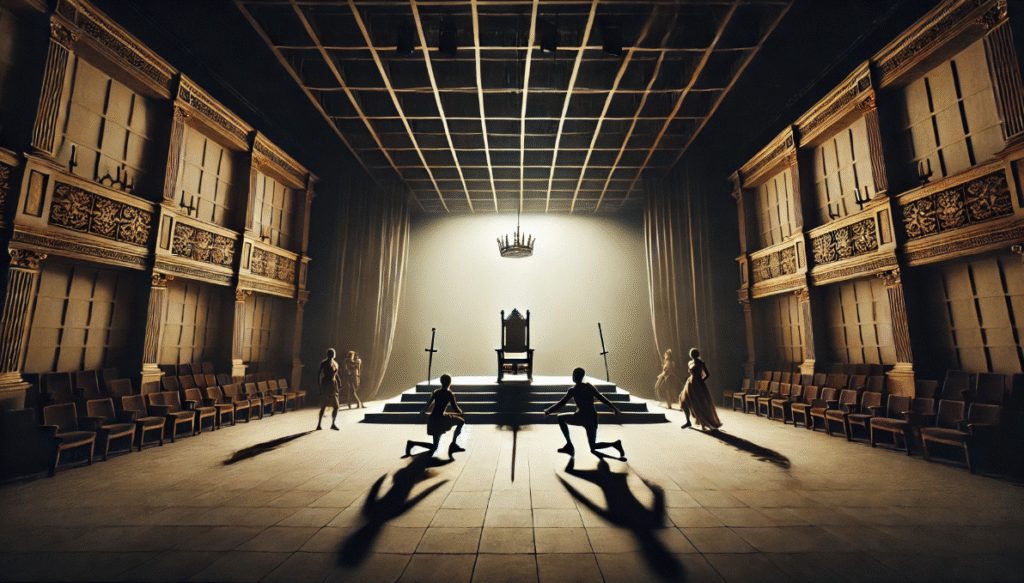
Exploring the Development of Shakespearean Stagecraft: Key Innovations That Transformed Theatre
When you think of Shakespeare, you might imagine grand, lavish stages, vibrant costumes, and dramatic performances. But in reality, the development of Shakespearean stagecraft was anything but extravagant. 🎭 Shakespeare’s innovations in stage design and performance techniques revolutionized theatre, focusing more on the power of storytelling than expensive props. Yet, many people overlook the profound impact these innovations had on the theatre world. In this article, we’ll dive into the key developments in Shakespearean stagecraft that transformed the art of theatre as we know it today. 🌟 Whether you’re a theatre enthusiast or a budding director, understanding these stagecraft innovations can help you reimagine how you approach the stage. Keep reading to explore how these timeless techniques still shape modern performances!
Table of Contents
Toggle1. What is Shakespearean Stagecraft?
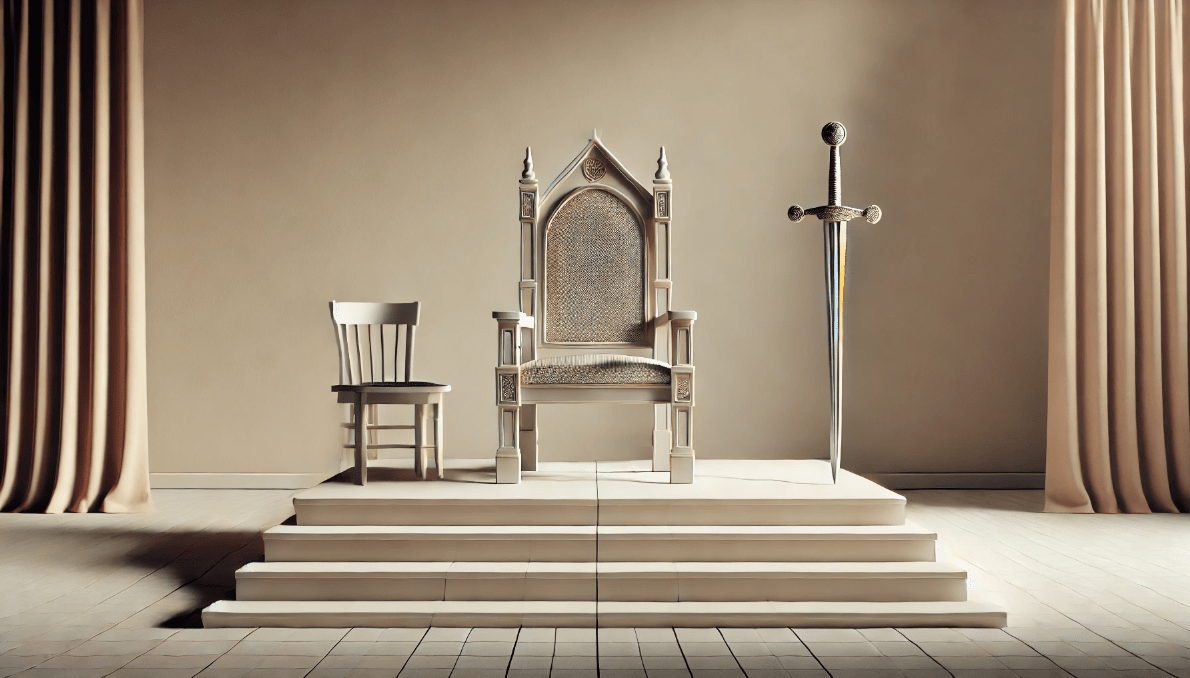
Shakespearean stagecraft refers to the innovative techniques used in the production of plays during the Elizabethan era, particularly in Shakespeare’s works. 🌟 Unlike modern theatre, which often relies on elaborate sets, advanced lighting, and special effects, Shakespeare’s stagecraft was minimalistic, yet highly effective. At the heart of this approach was the belief that the power of a play lay in its language, acting, and audience connection—rather than in extravagant visuals. 🎭
In the world of Shakespeare, stagecraft was about creating immersive experiences through simple yet symbolic elements. The actors, their movements, and the space around them did most of the storytelling. With limited resources, every prop, costume, and scene change was designed to evoke meaning and draw the audience into the drama.
Key features of Shakespearean stagecraft included:
- Minimal set design: Instead of detailed backdrops, the focus was on symbolic props and versatile set pieces that could suggest different locations.
- Audience engagement: The layout of the Globe Theatre encouraged close interaction between the performers and the crowd, making theatre a shared experience.
- Use of language: The dialogue itself, combined with actors’ physicality, created vivid images, setting the tone and atmosphere of the play.
By understanding Shakespeare’s stagecraft, we can see how these techniques continue to influence theatre today, proving that storytelling, rather than spectacle, is at the heart of a great performance. 🌟
2. The Key Innovations in Shakespearean Stagecraft
Shakespeare’s contributions to stagecraft were groundbreaking, changing the way theatre was performed and experienced. His innovations were not just about technical aspects but also how to tell a compelling story with limited resources. Let’s explore the key elements that set Shakespearean stagecraft apart. 🎭
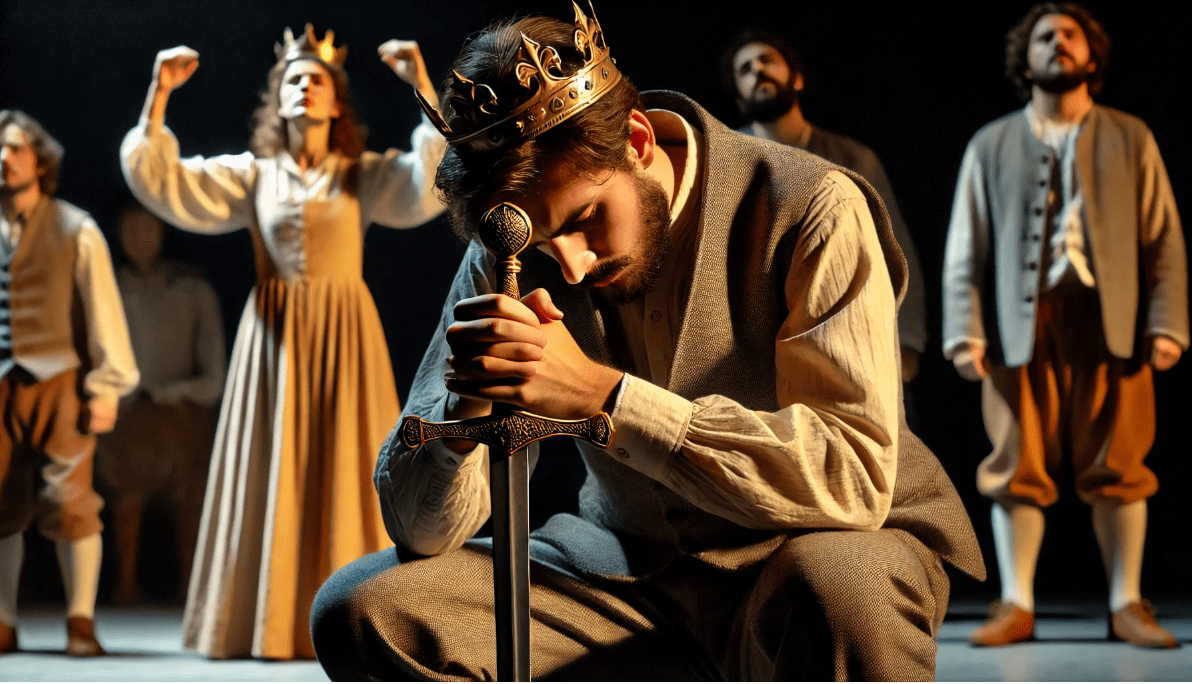
1. Minimalist Set Design
Instead of grand sets and heavy props, Shakespeare used simple, adaptable elements that allowed the imagination of both the actors and the audience to fill in the gaps. For example, a single prop, like a throne or a sword, could transform the stage into a royal court or a battlefield. 🎨 This minimalist approach focused the audience’s attention on the language and performances rather than on complex visuals.
2. Symbolic Use of Props and Costumes
Props weren’t just objects; they were symbols that carried meaning. A crown represented royalty, a dagger symbolized murder or betrayal. Costumes were designed to communicate character traits or status, making it easier for the audience to understand who each character was, even with minimal explanation. 👑👗
3. Dynamic Actor Movement
With no elaborate sets to rely on, actors had to be creative in their movements. Shakespearean stagecraft emphasized the importance of physical storytelling. Actors used gestures, body language, and facial expressions to convey emotions and intentions. The space on stage became a tool for storytelling, with actors physically shifting the mood and tone of the scene. 💃
4. Innovative Use of Lighting
In the open-air Globe Theatre, natural lighting was often used, creating a direct connection between the play and the time of day. This also meant that the audience could experience the play during daylight or dusk, which added an additional layer of realism to the performance. 🌅 As Shakespeare’s plays often dealt with themes of light vs. darkness, using the actual sunlight for atmosphere added a deeper dimension to the storytelling.
5. Overhead Rigging and Special Effects
While special effects in the 16th century were nowhere near as sophisticated as today’s technology, Shakespeare made effective use of what was available. The use of overhead rigging allowed for dramatic effects like the descent of ghosts or gods, or the sudden appearance of characters. These simple yet striking effects added a sense of magic and wonder to the performances. 🌟
6. Audience Interaction
One of the most innovative aspects of Shakespearean stagecraft was the direct engagement with the audience. In the Globe Theatre, the stage was open and close to the audience, encouraging a dynamic, almost communal experience. The audience wasn’t just watching a play; they were part of it, reacting to the performers and influencing the energy of the show. 🎤
3. The Influence of the Globe Theatre on Shakespearean Stagecraft
The Globe Theatre was more than just a venue for Shakespeare’s plays—it was the birthplace of many of his most innovative stagecraft techniques. 🎭 Understanding the Globe’s design and how it influenced Shakespearean stagecraft can help us appreciate why his plays are still so captivating today.
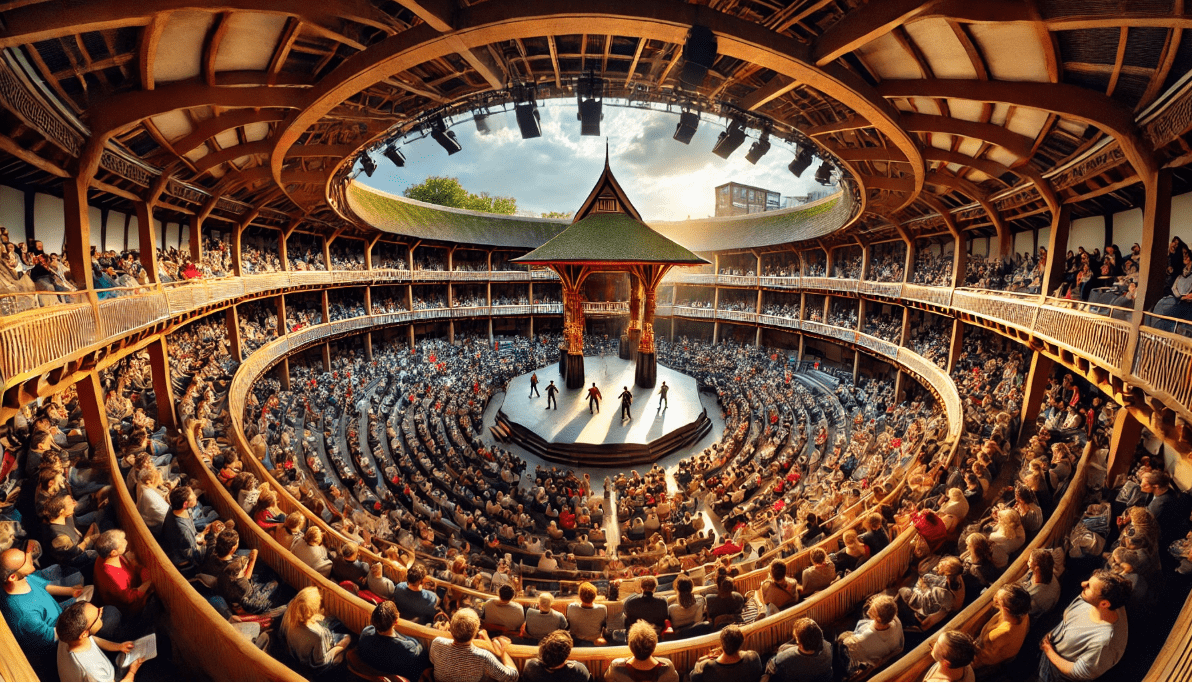
1. The Unique Design of the Globe Theatre
The Globe was a round, open-air theatre, designed to bring the audience closer to the action. The stage jutted out into the pit, allowing actors to perform just inches away from the audience. This intimate setting encouraged a direct connection between the performers and the crowd, making every moment feel more personal and engaging. 🌍
The theatre had a thrust stage—a platform that extended into the audience—making the performances feel more immersive. The actors had to be aware of their surroundings, projecting their voices and engaging with the audience on all sides. This design helped amplify the importance of the actor’s performance, as opposed to relying on elaborate sets.
2. The Use of Natural Light
One of the unique aspects of the Globe Theatre was its use of natural light. Without electric lighting, plays were staged during daylight hours, with the sun acting as a natural spotlight. 🌞 This reliance on daylight created a sense of immediacy and realism. It also connected the performance to the time of day, with scenes taking on different moods depending on the position of the sun. For example, the “magic hour” just before dusk could create a mystical atmosphere for plays like A Midsummer Night’s Dream.
3. Audience Placement and Engagement
The Globe’s design was revolutionary in that it placed the audience at the heart of the performance. The pit—where the “groundlings” (standing audience) gathered—was directly in front of the stage, making the actors accessible. This proximity encouraged audience participation, with reactions of laughter, applause, and even shouting being part of the performance experience. 🎤
Shakespeare understood that the energy of the audience could influence a performance. The actors had to play off the crowd’s reactions, creating a dynamic exchange that made each performance unique. This interactivity made the theatre feel like a shared experience, not just a passive observation.
4. The ‘Heavens’ and ‘Hell’ of the Globe Stage
The Globe Theatre’s stage was equipped with a special rigging system known as the “heavens.” This was an overhead structure that allowed for dramatic effects, such as the descent of gods or spirits, which added a sense of magic and wonder to Shakespeare’s plays. 🌟
Under the stage, there was a trapdoor used to represent “hell,” where characters could be swallowed into the earth or disappear mysteriously. These simple yet effective effects brought a new layer of depth to the stories, enhancing the emotional impact of the performances.
5. A Perfect Setting for Shakespeare’s Vision
Shakespeare’s plays were written to take full advantage of the Globe Theatre’s design. The structure’s intimacy, the use of natural light, and the accessibility of the actors helped make his storytelling come alive in a way that wasn’t possible in other venues of the time. The Globe became a symbol of Shakespeare’s ability to push the boundaries of stagecraft while keeping the focus firmly on the language and performance. 🎭
In many ways, the Globe Theatre’s design shaped how Shakespeare crafted his plays. The open stage and audience interaction encouraged him to write plays that were dynamic, engaging, and visually inventive—qualities that remain a hallmark of Shakespeare’s works today.
4. Shakespeare’s Approach to Actors and Movement
Shakespeare’s innovative use of actors and movement was central to his stagecraft. Since his plays were performed in a minimalist setting, where elaborate sets and props were limited, the actors’ performances and physical movements became the primary tools for storytelling. 🎭 Here’s how Shakespeare used actors and their movement to enhance the emotional impact and clarity of his plays.
1. Physicality as Storytelling
In Shakespeare’s theatre, actors didn’t just deliver lines—they physically embodied their characters. Their gestures, facial expressions, and movements were key to communicating emotions and plot points. 🎬 For example, a character’s stance could convey power, arrogance, or vulnerability. Actors would use body language to add depth to their lines, helping the audience understand the emotional undertones of a scene without relying on extravagant sets or complex dialogue.
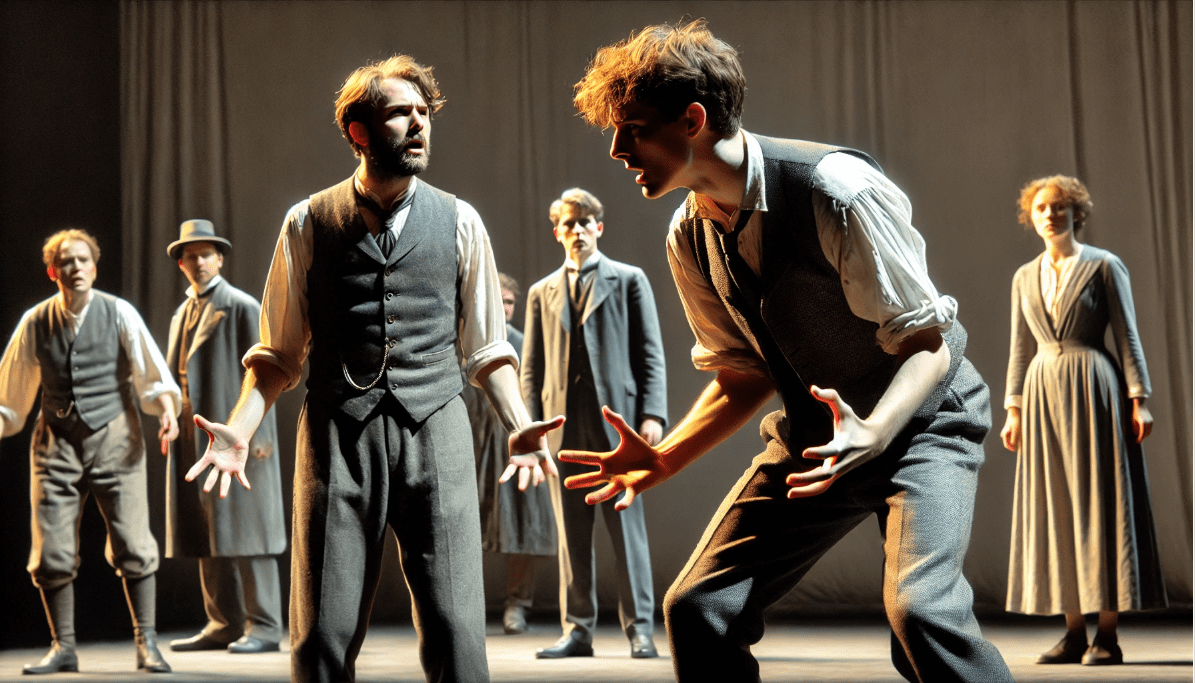
2. Blocking and Spatial Awareness
Blocking refers to the placement and movement of actors on stage. Shakespeare was known for his careful use of blocking to create meaning through the actors’ spatial relationships. The positioning of characters could show power dynamics, like a king standing tall above a servant, or a villain looming over a hero. 🏰 The use of different levels, such as elevated platforms or the stage itself, could convey status, strength, or vulnerability.
For instance, characters might walk towards or away from one another to signify emotional changes like conflict or reconciliation. These movements were simple yet powerful tools in conveying complex emotions without the need for dialogue-heavy explanations.
3. Emphasis on Vocal Delivery and Pace
Shakespeare placed great importance on vocal delivery as part of the actor’s movement. Actors needed to project their voices to be heard by an audience that sat far from the stage, but their delivery also had to convey emotion and subtext. 🎤 The pace of the dialogue—whether fast and frantic or slow and deliberate—could communicate a character’s state of mind. A tense silence or a rapid outburst could speak volumes, creating tension or surprise.
Actors would often pause before delivering key lines, letting the weight of their words sink in. This rhythm, combined with movement, helped draw the audience into the experience.
4. Physical Transformation for Multiple Roles
Shakespeare’s actors often played multiple roles in a single performance. As a result, quick changes in movement, posture, and voice were essential for distinguishing characters. 💥 Actors would adjust their physicality to show the difference between a noble king and a mischievous servant, even with little or no costume change.
This adaptability of movement was critical in making sure that the audience could easily follow the story, even if the same actor portrayed different characters in quick succession. By changing their body language and movement style, actors helped create a clear distinction between roles.
5. Choreographed Combat and Dance
Shakespeare’s plays often featured staged combat, dances, and even duels, which were crucial in advancing the plot and enhancing dramatic tension. ⚔️ These choreographed movements were tightly integrated into the storytelling. A well-executed sword fight could symbolize a character’s inner struggle or a power shift, while a dance could reflect the theme of a play—such as love, festivity, or betrayal.
The precision and grace of these movements were integral to keeping the audience engaged. Actors were trained in combat and dance to make these physical performances appear realistic and visually striking.
6. Emotional Expression through Movement
Finally, Shakespeare encouraged actors to convey emotional shifts through movement. A character’s emotions could be mirrored in how they moved across the stage. A noble character might stride confidently, while a troubled soul might shuffle or hesitate. These physical cues helped the audience read the subtext of a scene, adding emotional depth to the words being spoken. ❤️
Shakespeare’s approach to actors and movement relied on the simplicity and power of physical expression. Without relying on intricate sets or props, his actors told rich, multi-layered stories through their gestures, movements, and interactions. This emphasis on physical storytelling remains a core part of theatrical performances today.
5. Evolution of Shakespearean Stagecraft in Modern Theatre
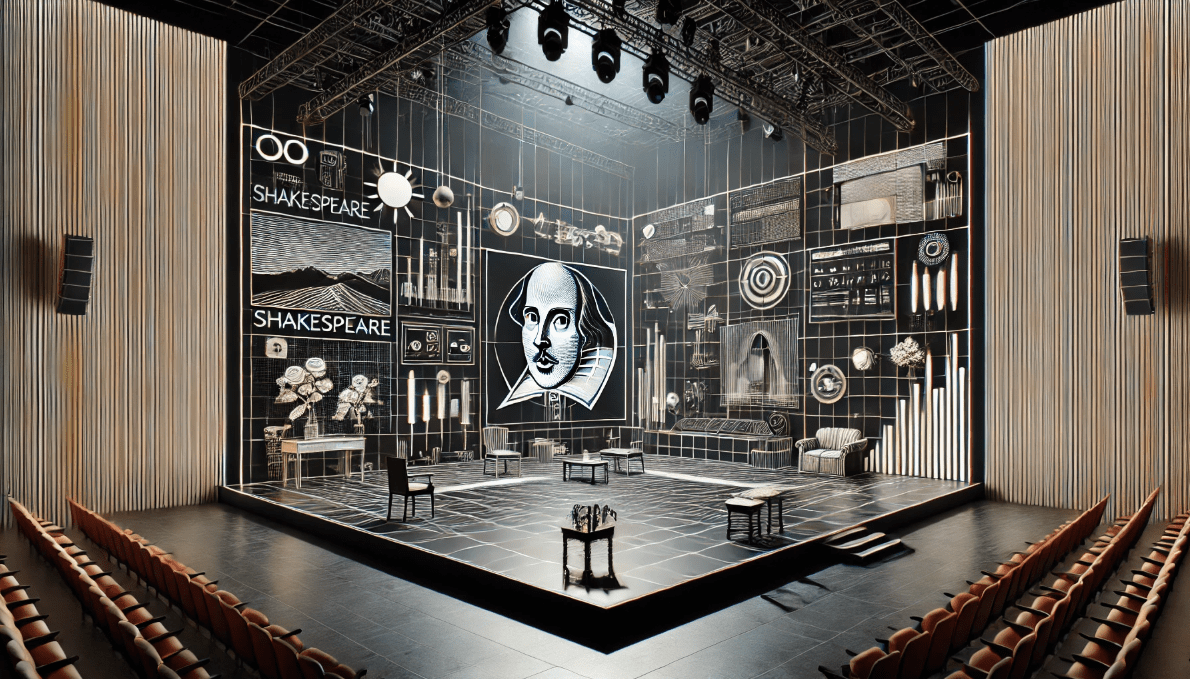
Shakespearean stagecraft continues to influence how theatre is performed today. While modern technology has introduced exciting new tools—like elaborate lighting, projections, and special effects—many of the core principles of Shakespeare’s stagecraft remain timeless. 🎭 Let’s explore how these innovations have evolved and continue to shape modern theatre.
1. Minimalism Meets Modern Design
Shakespeare’s minimalist approach to sets, where a few symbolic props or backdrops suggest entire worlds, is still very much alive in contemporary productions. While modern stage designers often use high-tech equipment, many directors still embrace minimalist sets to focus on the actors and their performances. ✨
For example, a modern production of Hamlet might use abstract lighting and a simple set design to highlight the characters’ emotional turmoil, much like how Shakespeare used minimal props to symbolize the internal conflict of his characters. Today, this approach allows for more creative interpretations and encourages audiences to engage their imagination.
2. Incorporating Technology and Special Effects
Though Shakespeare worked with rudimentary effects, today’s theatre is full of digital projections, 3D elements, and advanced sound and lighting technology. However, many modern productions still draw inspiration from Shakespeare’s use of special effects to create atmosphere, like the descent of spirits or the shifting of scenes. 🎇
For instance, digital projections can now create stunning visual backdrops that change in real time, echoing the simplicity and symbolism Shakespeare used. Similarly, lighting technology allows directors to capture the essence of natural light, creating moods that shift in line with the themes of the play—just like the daylight dynamics in the Globe Theatre.
3. Actor-Centered Storytelling
In the same way that Shakespeare’s plays relied on actors’ physicality and vocal delivery, modern theatre continues to prioritize strong, expressive performances. While actors now have access to microphones, high-tech costumes, and digital effects, the emphasis on the actor-driven narrative remains unchanged. 🎤
Directors today still look for ways to create a personal connection between the actors and the audience. Techniques like stage blocking, where actors’ positioning and movement convey power or vulnerability, are as relevant now as they were in Shakespeare’s time. A well-trained actor can still captivate an audience with just their voice and movement, much as actors did in the Globe Theatre.
4. Audience Engagement and Interaction
The Globe Theatre encouraged a close relationship between performers and the audience, and modern productions often seek to recreate this dynamic. Many contemporary productions break the fourth wall by directly engaging with the audience, whether through interactive elements or immersive experiences. 👀
For instance, some modern performances invite audience members onto the stage, creating a shared experience similar to the communal atmosphere of the Globe. The engagement might not always be as direct as Shakespeare’s time, but the goal remains—to immerse the audience in the story.
5. Creative Interpretations and Adaptations
Shakespeare’s stagecraft was about flexibility—using simple props and spaces to evoke a variety of settings. Modern theatre has taken this concept and run with it. Directors frequently reinterpret Shakespeare’s works with contemporary sets, modern costumes, or even new time periods, while still retaining the essence of Shakespeare’s minimalist stagecraft.
For example, a Macbeth set in a futuristic dystopia might use sleek, minimalist furniture and lighting to focus on the psychological tension, much like Shakespeare’s original approach. These modern adaptations show that Shakespeare’s principles of simplicity and focus on performance are still at the core of theatre today. 🕹️
6. Hybrid Stagecraft: Blending Old and New
Some theatre companies combine traditional and modern elements to create a unique experience. Imagine a Shakespeare production where actors perform with minimalistic props but are enhanced by projections or augmented reality. These hybrid approaches fuse the best of both worlds—honoring Shakespeare’s focus on storytelling while embracing technological advances that make theatre more visually immersive. 🌟
For example, the use of projected backdrops or motion capture technology allows modern productions to replicate some of the magical effects Shakespeare used, like characters ascending or disappearing into the “heavens.” These technologies amplify the story without overshadowing the performances.
6. Practical Tips for Aspiring Theatre Practitioners
If you’re an aspiring theatre practitioner, whether you’re an actor, director, or designer, understanding and applying Shakespearean stagecraft can take your skills to the next level. While modern theatre offers many advanced tools, the timeless principles of simplicity, creativity, and actor-driven storytelling from Shakespeare’s stagecraft can still serve as your foundation. Here are some practical tips to help you get started: 🎭
1. Embrace Minimalism in Set Design
One of the key elements of Shakespearean stagecraft is the use of minimalistic sets. Instead of relying on complex backdrops, focus on using a few key props or versatile elements that suggest different locations. 🏰 A single chair can symbolize a throne, or a cloth can transform a whole scene. By stripping away the excess, you let the actors and story take center stage. Try designing sets that focus on symbolic meaning rather than realism—this will help you tell a powerful story with limited resources.
2. Focus on Actor-Driven Storytelling
Shakespeare’s plays relied heavily on the actors’ ability to convey emotion through their physicality and voice. Practice using body language to express a character’s emotions and intentions. 💪 Remember, in Shakespeare’s time, actors didn’t have microphones, elaborate sets, or special effects to rely on—everything came from their performances. As a director or actor, prioritize clear and expressive movement that conveys the essence of the character without relying on too many props or distractions.
3. Experiment with Blocking for Dramatic Effect
In Shakespeare’s plays, blocking (the arrangement of actors on stage) was crucial in conveying power dynamics, emotional shifts, and relationships between characters. ✨ Practice experimenting with how you position actors on stage to create visual impact. For example, having a character stand above others or keeping characters physically distant can highlight tension or conflict. You don’t need complex stage designs to tell a powerful story—how your actors move and interact within the space speaks volumes.
4. Use Light and Space Creatively
Shakespearean stagecraft often made use of natural light and the space on stage to enhance the mood and atmosphere. 🌞 Try using lighting creatively to set the tone of your scenes. If you’re working with a limited budget, you can achieve a lot with basic lighting techniques, such as shadows or simple lighting cues that change the mood of the play. Similarly, explore how you can use the physical space on stage—whether it’s a corner, elevated platform, or even a trapdoor—to create dramatic effects or symbolize deeper themes.
5. Simplify Costume Choices for Maximum Impact
Shakespeare’s costume designs were often symbolic rather than realistic. A king might wear a crown to signify power, while a poor servant might wear ragged clothing to indicate their status. 👑 When designing costumes, focus on symbolism. You don’t need expensive, elaborate outfits to create an impact—simple changes in color, texture, or accessories can speak volumes about a character’s role and personality.
6. Engage the Audience with Direct Interaction
One of the hallmarks of Shakespearean theatre was the direct interaction between performers and the audience. While modern theatre may have moved away from this, incorporating some form of audience engagement can make your performances more dynamic and memorable. 👀 Whether it’s breaking the fourth wall or simply acknowledging the audience’s presence, encourage your performers to interact with the crowd. This can create a more immersive experience and bring energy to the performance.
7. Learn to Use Quick Scene Changes and Pantomime
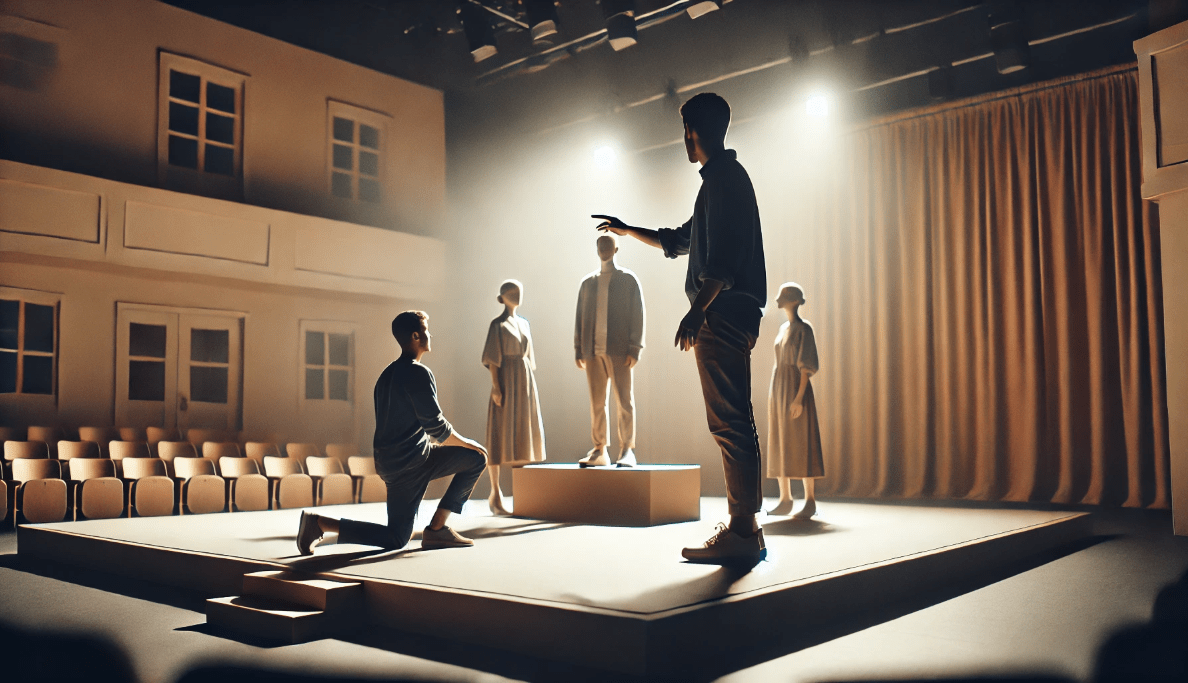
In Shakespeare’s time, scene changes had to be quick and often minimal. Directors used creative methods like pantomime to convey action or scenery changes without elaborate sets. Practice using pantomime techniques—where actions are mimed rather than shown through elaborate props—this allows you to focus more on the actor’s movements and emotions. You can also experiment with quick transitions using simple props or changes in lighting to convey different scenes effectively.
8. Don’t Be Afraid to Experiment
Shakespeare’s stagecraft was innovative because he pushed boundaries and experimented with what was possible. As an aspiring practitioner, don’t be afraid to take risks and think outside the box. 🧠 Whether you’re reinterpreting Shakespeare’s plays or creating something new, allow yourself the freedom to explore unconventional ideas, combining traditional techniques with modern elements.
Shakespearean stagecraft may have emerged centuries ago, but its influence continues to shape modern theatre in profound ways. From minimalist set designs to the powerful use of actor movement, Shakespeare’s innovations were rooted in a deep understanding of storytelling through performance, not just spectacle. 🎭
As we’ve explored, his approach emphasized the actor’s craft, creative use of space, and engaging the audience through direct interaction—all principles that remain relevant today. Whether you’re a director, actor, or designer, embracing these timeless techniques can help you create compelling, memorable theatre that captivates audiences without relying on excessive technology or complex sets. 🌟
Frequently Asked Questions (FAQs)
1. What was unique about Shakespearean stagecraft?
Shakespearean stagecraft was unique because it emphasized simplicity and creativity. Rather than relying on elaborate sets or props, the focus was on actor performances, movement, and language. Minimal props were used symbolically, and the audience’s imagination played a key role in visualizing the scenes.
2. How did the Globe Theatre influence Shakespearean stagecraft?
The Globe Theatre was crucial to the development of Shakespearean stagecraft. Its open, circular design allowed for close interaction between actors and the audience. The use of natural lighting and the thrust stage (where the stage extended into the audience) made performances more dynamic and immersive.
3. What are the main elements of Shakespearean stagecraft?
Key elements of Shakespearean stagecraft include minimalist set designs, symbolic props and costumes, actor-driven storytelling, and dynamic movement. These elements were designed to engage the audience’s imagination, focusing on the actors’ physicality, vocal delivery, and emotional expression.
4. How did actors use movement in Shakespearean theatre?
Actors in Shakespearean theatre relied on physicality to express emotions and tell the story. Their body language, gestures, and movement conveyed character traits and emotional shifts. This was especially important since there were minimal sets and props to rely on, making actor movement crucial to conveying meaning.
5. Did Shakespeare’s stagecraft rely on special effects?
While Shakespeare’s stagecraft did include rudimentary special effects, such as overhead rigging for ghostly appearances or trapdoors for dramatic entrances, it was not reliant on technology. Instead, actor creativity and simple staging techniques were used to convey the supernatural or dramatic moments.
6. How did Shakespeare’s stagecraft affect modern theatre?
Shakespeare’s innovations laid the groundwork for many modern theatre techniques. Today, directors still use minimalist design, actor-driven performances, and symbolic props to create powerful and engaging productions. His focus on storytelling rather than spectacle continues to inspire contemporary theatre practices.
7. What role did the audience play in Shakespearean theatre?
In Shakespearean theatre, the audience had an interactive role. The Globe Theatre’s design encouraged a close relationship between performers and the crowd, with audience reactions influencing the energy of the performance. The audience wasn’t just a passive observer but an active participant in the experience.
8. How can I apply Shakespearean stagecraft techniques today?
To apply Shakespearean stagecraft, focus on simple, adaptable sets that allow for creative interpretations. Prioritize actor performance and physicality, and use symbolic props and lighting to enhance the story. Keep the audience engaged by emphasizing interaction and emotional connection over lavish spectacle.
